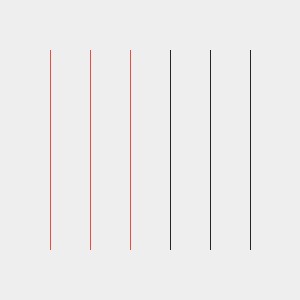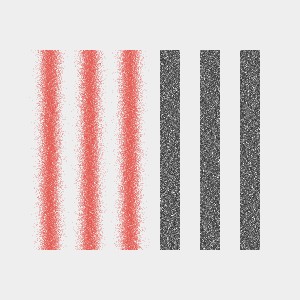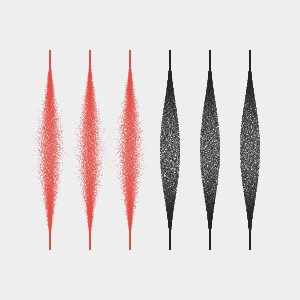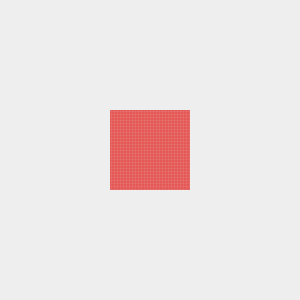randomGaussian()
randomGaussian() is a function that gives you a random number from a normal (0,1) distribution. This means that the average of all returned numbers is 0 and that almost all values are between (-3,3). Actually you could get any value but values outside of the (-3,3) range will be rare.
How to use it
float val = randomGaussian();- without any special parameters, the function will return some floating point number, with a very high probability of hitting the(-3,3)rangefloat val = 10.0 * randomGaussian();- to scale your result, simply multiply by the desired amount; in this case the returned value will very probably be in the(-30,30)rangefloat val = 5.0 + 10.0 * randomGaussian();- to shift the range of probable numbers just add the desired offset; in this case the returned value will very probably be in the(-25,35)range
What is it for
Generally it's primarily used to distort rendered points or to blur things.
Example: lines
Let's start with rendering lines. But we will not simply use the line() function; instead we will draw them point by point.
color black = color(34, 34, 34); // #222222
color white = color(238, 238, 238); // #EEEEEE
color red = color(225, 76, 69); // #E14C45
void setup() {
size(300, 300);
smooth(8);
noFill();
strokeWeight(0.8);
background(white);
for (int x=50; x<=250; x+=40) {
for (float y=50; y<250; y+=0.01) {
if (x<150) {
stroke(red, 100);
point(x,y);
} else {
stroke(black, 100);
point(x,y);
}
}
}
}

Now let's distort the red points with randomGaussian() and the black points with regular random() to illustrate the difference between the two functions.
color black = color(34, 34, 34); // #222222
color white = color(238, 238, 238); // #EEEEEE
color red = color(225, 76, 69); // #E14C45
void setup() {
size(300, 300);
smooth(8);
noFill();
strokeWeight(0.8);
background(white);
for (int x=50; x<=250; x+=40) {
for (float y=50; y<250; y+=0.01) {
if (x<150) {
stroke(red, 100);
point(x+5*randomGaussian(), y); // add some random value to the x position
} else {
stroke(black, 100);
point(x+5*random(-2, 2), y); // add some random value to the x position
}
}
}
}

You can easily see the difference now. The pixels of the red bars are concentrated near the middle while the pixels of the black bars are uniformly distributed.
We'll add one additional modification to get a more interesting effect.
color black = color(34, 34, 34); // #222222
color white = color(238, 238, 238); // #EEEEEE
color red = color(225, 76, 69); // #E14C45
void setup() {
size(300, 300);
smooth(8);
noFill();
strokeWeight(0.8);
background(white);
for (int x=50; x<=250; x+=40) {
for (float y=50; y<250; y+=0.01) {
// transform y to angle from -PI, PI
float sy = map(y, 50, 250, -PI, PI);
// transform angle to values from -1 through 1 to -1
float csy = cos(sy);
// transform above to go from 0 to 5 and back to 0 (smoothly)
float f = map(csy, -1, 1, 0, 5);
if(x<150) {
stroke(red, 100);
point(x+f*randomGaussian(), y);
} else {
stroke(black, 100);
point(x+f*random(-2,2), y);
}
}
}
}

Example: Blurring square
In the following example we'll render a square from points and use randomGaussian() to spread the points on each frame.
float s = 10*sin(step); this statement calculates the factor the value returned by randomGaussion() will be multiplied with. in this case s will sway between -10 and 10.
color black = color(34, 34, 34); // #222222
color white = color(238, 238, 238); // #EEEEEE
color red = color(225, 76, 69); // #E14C45
void setup() {
size(300, 300);
smooth(8);
noFill();
stroke(red,40);
}
float step = 0;
void draw() {
background(white);
translate(150, 150); // set origin in the middle of the screen
float s = 10*sin(step);
for(float x=-40;x<40;x+=0.3) {
for(float y=-40;y<40;y+=0.3) {
point(x+randomGaussian()*s,y+randomGaussian()*s);
}
}
step += PI/30.0;
}
